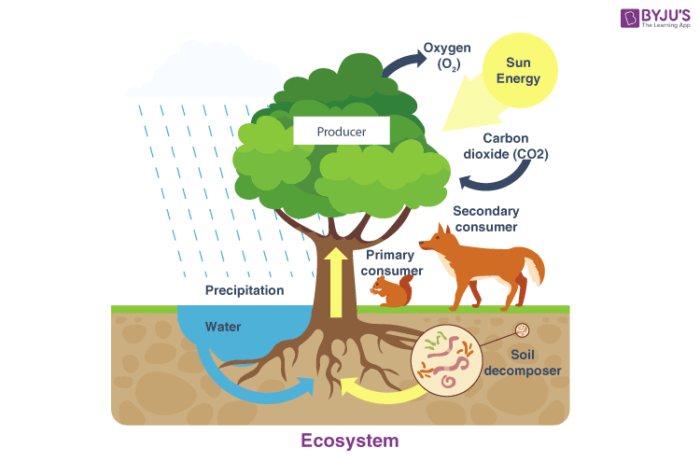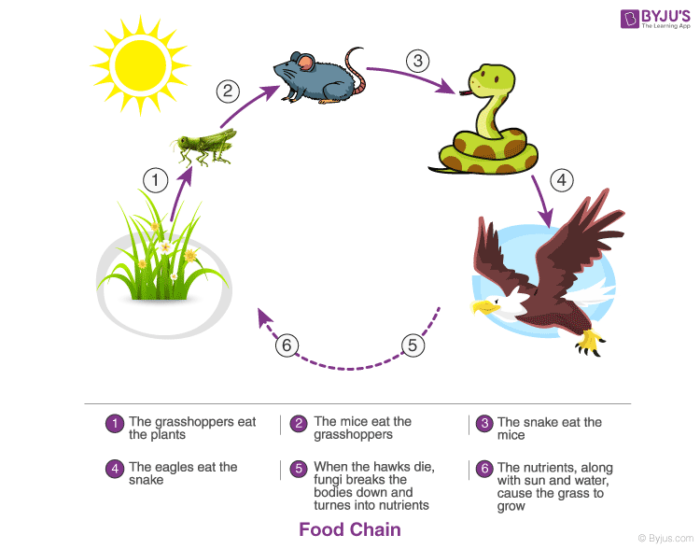This topic explains about the ecosystem and the components of ecosystem. An ecosystem is a group or community composed of living and non-living things and their interactions with each other. They can be natural as well as artificial. Every ecosystem has two components, namely, biotic components and abiotic components. Biotic components refer to all living organisms in an ecology while abiotically refers to the non-living things. These biotic and abiotic interactions maintain the equilibrium in the environment. Let’s go through the components of the ecosystem in detail.
Table of Contents
Components of Ecosystem
Biotic components are the living things that have a direct or indirect influence on other organisms in an environment. For example plants, animals, and microorganisms and their waste materials.
Abiotic components of an ecosystem include all chemical and physical elements i.e. non-living components. Abiotic components can vary from region to region, from one ecosystem to another. They mainly take up the role of life supporter. They determine and restrict the population growth, number, and diversity of biotic factors in an ecosystem. Hence, they are called limiting factors.
A terrestrial ecosystem consists of abiotic factors like climate, type of soil or rock, altitude, temperature, nutrients, and minerals, whereas abiotic components in an aquatic ecosystem include dissolved gases, depth of water, salinity, pH of water, light intensity etc.

The significance of Biotic and Abiotic Components
Biotic components can be classified into three categories:
Producers: These include all the autotrophs. They use light energy and synthesize food on their own, e.g. plants, green algae, etc.
Consumers: These include all the heterotrophs that directly or indirectly depend on producers for their food. Consumers are further categorized as herbivores, carnivores, omnivores and parasites.
Decomposers: These include saprophytes which act on dead matter and decay them for their nutrition.
The relevance of biotic and abiotic components in an environment appears when they start interacting with each other. For example, biotic elements like plants provide food for other organisms. The soil is the abiotic element which supports the growth of the plants by providing nutrients and other essential elements. Biotic components depend on abiotic components for their survival and help in the formation of abiotic factors like soil, nutrients, etc.
Food Chains and Webs
A food chain is a chain which shows how organisms are linked to each other through food. A food web shows how two food chains are connected. A single food web consists of many food chains. Every food chain begins with producers and ends with top carnivores.

The energy flow from one level to another level in a food chain gives the trophic level of an ecosystem. The producers come at first trophic level followed by herbivores (primary consumers), then small carnivores (secondary consumers) and large carnivores (tertiary consumers) occupy the fourth trophic level.
Recommended Videos
Ecosystem

Major Abiotic Factors

Frequently Asked Questions – FAQs
What is the ecosystem?
The ecosystem is the community of living organisms in conjunction with non-living components of their environment, interacting as a system.
What are the different types of ecosystems?
The different types of the ecosystem include:
Terrestrial ecosystem
Forest ecosystem
Grassland ecosystem
Desert ecosystem
Tundra ecosystem
Freshwater ecosystem
Marine ecosystem
What are the functional components of an ecosystem?
The four main components of an ecosystem are:
(i) Productivity
(ii) Decomposition
(iii) Energy flow
(iv) Nutrient cycling
Which ecosystem do we live in?
We live in a terrestrial ecosystem. This is the ecosystem where organisms interact on landforms. Examples of terrestrial ecosystems include tundra, taigas, and tropical rainforests. deserts, grasslands and temperate deciduous forests also constitute terrestrial ecosystems.
What is the structure of the ecosystem?
The structure of the ecosystem includes the organisms and physical features of the environment, including the amount and distribution of nutrients in a particular habitat. It also provides information regarding the climatic conditions of that area.

very well explained
Superb explanation